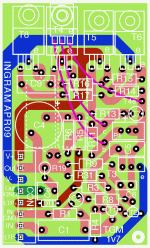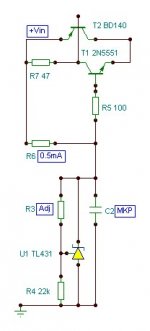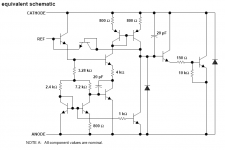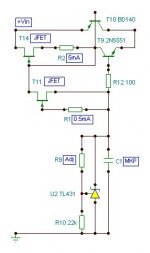Bigun said:
By introducing RC filters on both +ve and -ve rails to the amplifier front end (LTP and VAS) the cross talk is greatly reduced. I see around -100dB. This maybe good enough.
Hi Gareth,
The issue of cross talk is a bit overblown. Including some of the methods to improve PSRR (active current source, current mirror, RC filters) you can drive it down to the point where it will be impossible to hear crosstalk.
I have done some testing with my 6 channel Patchwork that is operating on a single supply and found that crosstalk was not a problem. This is with amps that use a resistor current source for the LTP.
Member
Joined 2009
Paid Member
Thanks, that's good to know. Given that your amps are designed for much higher power levels than the TGM I should be even safer.
I anticipate building a Lightspeed attenuator for the volume control. People familiar with this approach say it needs a clean power supply for the LEDs which lends more weight to the dual supply option.
The DigiKey power supply filter caps arrived today - getting closer to a full parts list.
I anticipate building a Lightspeed attenuator for the volume control. People familiar with this approach say it needs a clean power supply for the LEDs which lends more weight to the dual supply option.
The DigiKey power supply filter caps arrived today - getting closer to a full parts list.
Gareth
I don`t know what the simulation says to you, I only know that ideally all stages should be isolated from each other. A separate clean regulated power for the voltage amplifying section would most definitely be worth the effort. It`s not just about crosstalk.
I don`t know what the simulation says to you, I only know that ideally all stages should be isolated from each other. A separate clean regulated power for the voltage amplifying section would most definitely be worth the effort. It`s not just about crosstalk.
Member
Joined 2009
Paid Member
Hi Lumba - I agree, with the dual supply there is now the possibility of designing for a nice and quiet front end supply. But psu design is another venture. I think I'll leave the SuperJung regulators for the headphone brigade but I still want something good.
With a good regulator, might the low noise low power supply be drawn from the same transformer as the main psu? after the same rectifier ? after the same filter caps ?
Does anybody have a recommendation for a low dropout low noise regulator (I'll need both + and - versions) ? The LT1963A looks good on paper.
Of course I now have a pair of PCBs based on the TGM2 version which although they are quite suitable, may not reflect my final power supply configuration. They also allow less chance for error since I can't upgrade or make changes to the amp separate from the psu. Perhaps somebody out there would like one of my pcb's to try constructing this design ?
So going down the route of multi-channel amplifiers with a dual supply...
I've doodled a simple pcb which would give me something small and simple to try out with a bench supply. It also puts the devices on one edge (a more traditional approach) so that I don't have to worry about heatsink design at this point but can simply bolt it onto something cold (hmmm, what about a 6-pack in the fridge ?).
p.s. output device emitter load resistors mounted underneath pcb.
With a good regulator, might the low noise low power supply be drawn from the same transformer as the main psu? after the same rectifier ? after the same filter caps ?
Does anybody have a recommendation for a low dropout low noise regulator (I'll need both + and - versions) ? The LT1963A looks good on paper.
Of course I now have a pair of PCBs based on the TGM2 version which although they are quite suitable, may not reflect my final power supply configuration. They also allow less chance for error since I can't upgrade or make changes to the amp separate from the psu. Perhaps somebody out there would like one of my pcb's to try constructing this design ?
So going down the route of multi-channel amplifiers with a dual supply...
I've doodled a simple pcb which would give me something small and simple to try out with a bench supply. It also puts the devices on one edge (a more traditional approach) so that I don't have to worry about heatsink design at this point but can simply bolt it onto something cold (hmmm, what about a 6-pack in the fridge ?).
p.s. output device emitter load resistors mounted underneath pcb.
Attachments
AKSA said:According to an academic friend in the psychoacoustic field, if H2/H3 are slightly above 60dB down, and all higher harmonics are more than 60dB down, there will be masking, and the impression will be one of 'warmth'. Further, the subliminal effects of unhead, objectionable harmonics will be completely masked, and the listening experience will be judged subjectively pleasant.
I assume that this academic has a name a relevant peer reviewed papers worth referencing?
Member
Joined 2009
Paid Member
Hugh no doubt has the relevant details, but I believe this 'masking' of sound is a well known and well documented phenomena.
this link claims that it is a part of the principle behind MP3 for example:
http://www.listeninc.com/files/pdf/MP3_testing.pdf
I assume that the bad thing about this masking is that it means we don't actually hear all that is in the music ?
this link claims that it is a part of the principle behind MP3 for example:
http://www.listeninc.com/files/pdf/MP3_testing.pdf
I assume that the bad thing about this masking is that it means we don't actually hear all that is in the music ?
Member
Joined 2009
Paid Member
Lumba, Why is this your recommendation - an integrated regulator device is simpler (fewer parts, smaller footprint) and has higher performance does is it not ?
Bigun said:I assume that the bad thing about this masking is that it means we don't actually hear all that is in the music ?
Oh man, as stated in that paper the masking curves in MP3 generation are…..
"used to determine recorded frequency content that would be inaudible due to its close proximity to similar tones of greater amplitude".
This has absolutely noting, zip, nada, nil to do with the claim of H2 masking H7, for example.
Member
Joined 2009
Paid Member
Bigun said:oh well, that's all I found after a quick Google. Did you try looking ?
I'm waiting for the peer-reviewed references demonstrating that:
"if H2/H3 are slightly above 60dB down, and all higher harmonics are more than 60dB down, there will be masking, and the impression will be one of 'warmth'. Further, the subliminal effects of unhead, objectionable harmonics will be completely masked, and the listening experience will be judged subjectively pleasant."
Gareth,
integrated regulators are not good sonically, have complex circuitry, poor bandwidth and other flaws.
integrated regulators are not good sonically, have complex circuitry, poor bandwidth and other flaws.
Member
Joined 2009
Paid Member
Lumba, I have to overcome my laziness, so I'd be wanting to understand a bit more about the integrated regulators. I'm not sure complex circuitry is a problem in and of itself. Not good sonically is an issue. But why are they not good sonically ?
Banwidth - how much do I need ? the LT1963A has less than 40uV of noise over a bandwidth of 10Hz to 100KHz.
Banwidth - how much do I need ? the LT1963A has less than 40uV of noise over a bandwidth of 10Hz to 100KHz.
Attachments
Gareth,
I have made life difficult for you with my suggestions, I know. Give me some time, please, it`s half past four in the morning here, I have to get some sleep.
I have made life difficult for you with my suggestions, I know. Give me some time, please, it`s half past four in the morning here, I have to get some sleep.
Lumba Ogir said:John,
I`m not happy about it at all, believe me, but zener diodes are even worse.
Does TL431 use a Zener diode for the reference?
Wavebourn,
may do, it has however a more favourable noise, turn-on and impedance characteristic but also some repugnant features like massive feedback and intricate circuit topology, depending on brand. Some IC regulators use 1.2V reference, which is preferable from a functional point of view.Does TL431 use a Zener diode for the reference?
- Status
- Not open for further replies.
- Home
- Amplifiers
- Solid State
- TGM Amplifier ?



